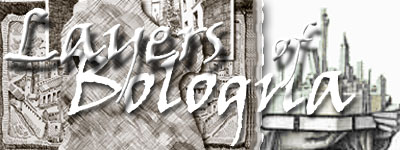
|
In 1219 Reginald of Orleans, a follower of Domenico Guzman, founder of the
Dominican Order of preaching monks, moved the existing small community to San
Nicolò delle Vigne, where today stands the basilica of San Domenico. At
that time, however, it was in the outskirts of the city, in the middle of
vineyards, thus the name of the small church. (One can still see vineyards
while walking in Villa Ghigi, not too far along off of Via Mamolo just past the
Piazza di Porta San Mamolo.) San Domenico himself arrived that same year and,
before his death in 1221, had made it an important center for the Order. Since
that time, the history of Bologna and the work of San Domenico have been
closely intertwined.
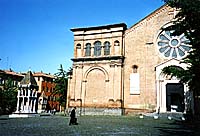
River stones that recall a medieval past cover Piazza San Domenico
massaging my feet through leather-soled shoes as I approach the church. Two
copper statues on top of high columns stand there, the one in the center of San
Domenico (1627, designed by Guido Reni) and the other of the Madonna (1632,
Giulio Cesare Conventi). Perhaps more interesting to me though are the other
two pyramidal structures that rise up. They are the tombs of two revered heroes
of medieval Bologna. My first reaction to them had been "I wonder what prince
or famous warrior they memorialize?" However, Rolandino de'Passeggeri was an
important notary and government official (1305) and Egidio Foscherari, an
expert in Church Law (1289). Bologna's heroes have always been her famous
Doctors of the Law ("The University of Bologna: Alma Mater
Studiorum").

I approach the main door of the church and allow San Domenico himself to
welcome me as he looks down from the lunette, dressed in the characteristic
white and black flowing robes of his order. His sweet bearded face and
beckoning motion encourage me to enter. The quiet and coldness of the huge gray
interior envelop me.
I stop outside the sixth chapel on the right and welcome the harmony and
peace of the enclosed golden space. The white marble tomb of San Domenico
shines from inside the shadows, as if lit from an inner light. As I look at the
chapel I think of the time and collection of artists it required to create
it. The tomb to honor San Domenico took five centuries to complete, from the
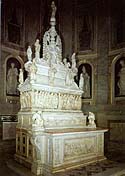 thirteenth to the eighteenth. In our world of quick results and fast turnover,
it is difficult to imagine. From 1265-1267 Nicola Pisano worked with others
less famous to carve the saint's sarcophagus that depicts scenes from his
life. Two hundred years later (1469-1473) Nicolò dell'Arca added the
magnificent marble crown to the sarcophagus, considerd his
capolavoro which defines him forever in art books. Did he believe
it to be his masterpiece? Did the young Michelangelo Buonarroti realize that his
angel holding the torch would resemble the David that we would all flock to
Florence to see? The tomb, begun even before the time of Taddeo Pepoli
(1337-1347), was still being created during the signoria of
Giovanni II Bentivoglio (1463-1506). Pazienza . . .
thirteenth to the eighteenth. In our world of quick results and fast turnover,
it is difficult to imagine. From 1265-1267 Nicola Pisano worked with others
less famous to carve the saint's sarcophagus that depicts scenes from his
life. Two hundred years later (1469-1473) Nicolò dell'Arca added the
magnificent marble crown to the sarcophagus, considerd his
capolavoro which defines him forever in art books. Did he believe
it to be his masterpiece? Did the young Michelangelo Buonarroti realize that his
angel holding the torch would resemble the David that we would all flock to
Florence to see? The tomb, begun even before the time of Taddeo Pepoli
(1337-1347), was still being created during the signoria of
Giovanni II Bentivoglio (1463-1506). Pazienza . . .
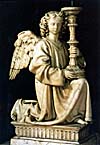
The two torch-bearing angels, one on each side of the altar slab, charm
me. I look at the one on the left done by Nicolò dell'Arca (1469-1473)
and compare it to his La Pietà that I have just experienced
in Santa Maria della Vita. The angel's quiet sweetness strikes me. The drama of
the group of statues is missing. The gown dwarfs the angel's body. The face is
one of a young child. There is no movement. Its beauty is simple, sweet, still,
graceful, delicate.
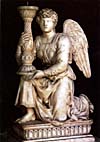
On the other side of the altar is Michelangelo's angel, whose gown does not
mask the strong body underneath, the pent-up energy. The young angel holds
still for a moment, but his mind is on flight, movement. He would seem out of
place in the angel-world. His athletic hulk holds a thick torch. He looks out
brashly, not down demurely like his partner. I think about old Nicolò
from Puglia and young Michelangelo. The angels are simple, perhaps the least
complicated figures of the tomb, but in the comparison I can understand better
the passage of time that the Ark represents.
Michelangelo also authored two other statues surrounding the crown of the
tomb: San Procolo and San Petronio. I join the group of tourists that peer
around its edges, searching them out. The statues proclaim themselves to even
those unfamiliar with the two saints. San Petronio (second from the left in the
front) holds the city of Bologna safely in his hands, while Roman San Procolo,
his sword missing, stands guard, second from the right in the back.
As I continue toward the exquisite coro behind the main altar,
I stop at Filippino Lippi's Matrimonio Mistico di Santa Caterina
(1501), which hangs in the chapel just to the right of the presbytery. The
lightness and brightness of its colors, especially the red of St. Catherine's
flowing gown, glows in the dark hollow of the huge church.
Handwritten signs direct me to the choir. I walk into the huge space, which
is normally draped and dark, but today brilliant with strong afternoon sun
shining in through the immense windows. I go to the opposite end of the room
and prepare myself to enter into the world of the monk Damiano da Bergamo
(1528-1551). The choir consists of stalls formed by separate panels of inlaid
wood, exquisitely expressive and complex. Scenes from the Old and New Testament
show the monk's perception of his world and allow a glimpse inside, to see his
heart and soul. With tiny slivers of wood, in tones that range from black to
limpid beige, he has depicted living, breathing Madonna's, saints and
townspeople. He has created action and drama. He has built hill towns and
castles with walls and houses. He has shown ducks floating serenely down the
stream while Saint Stephen is being stoned to death. Flowers pop up in front of
the Nativity scene and skies move as the wind blows the clouds away. God looks
down and angels too, just as the people look down from the windows above the
flagellation of Christ.

I feel like I could walk in. No, I am pulled deep, deep into the space. I
think of the Dominican monks whose backs over the centuries have felt the wood
behind them and wonder if they felt the warmth of the wood, or its smooth
hardness, or were they always too deep in prayer and contemplation to notice. I
want to touch it -- to feel its smoothness and warmth, but I know I cannot. I
rub my fingers together to help dissipate the urge that overwhelms them. I can
only imagine its exquisite feel. I think of the artist and his patience. I
think of his hands and his eyes, how tired he must have felt from the tedious
work. I wonder if he ever thought about the joy and inspiration his work would
give to us centuries later.
|

|
